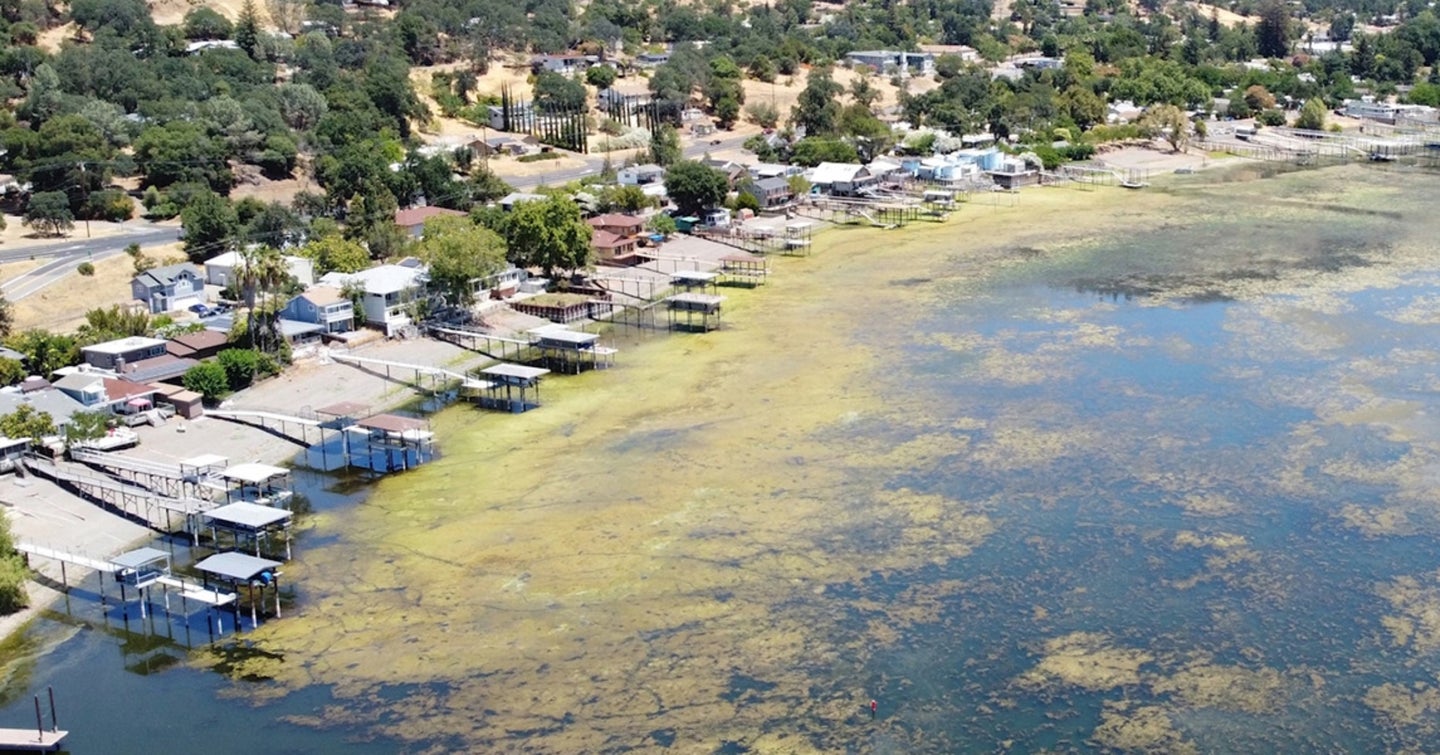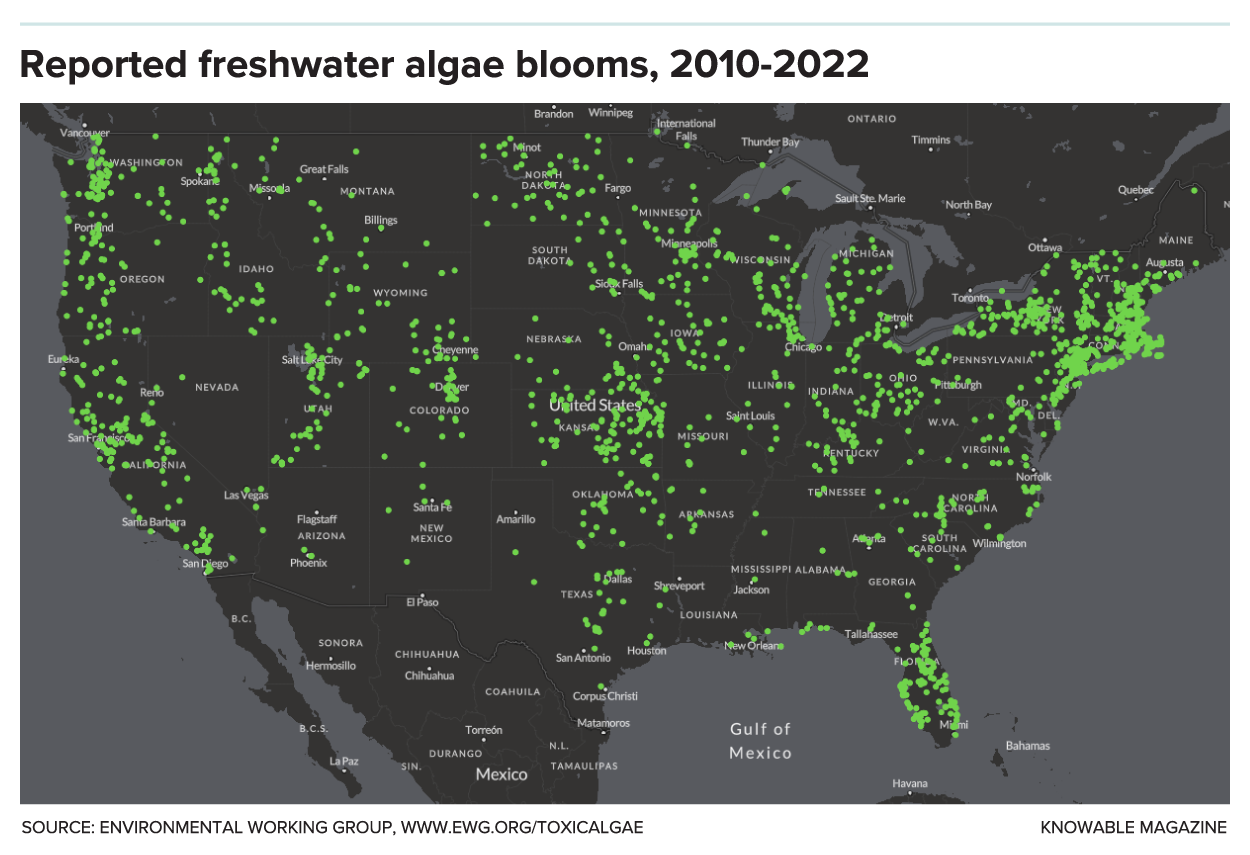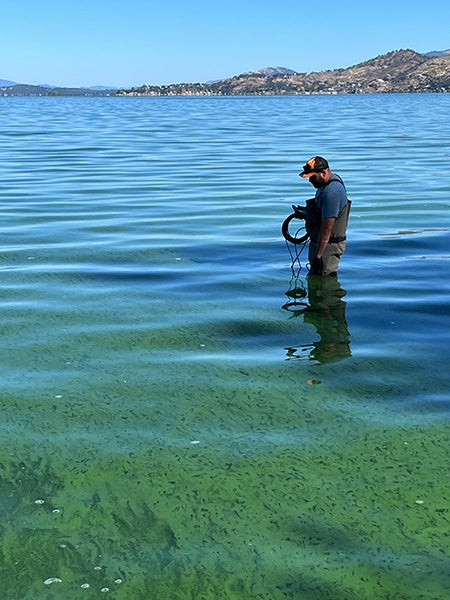
This article was originally published on Knowable Magazine.
Jesus Campanero Jr. was a teenager when he noticed there was something in the water. He once found a rash all over his body after a swim in nearby Clear Lake, the largest freshwater lake in California. During summertime, an unbearable smell would waft through the air.
Then, in 2017, came the headlines, after hundreds of fish washed up dead on the shore. “That’s when it really started to click in my head that there’s a real issue here,” says Campanero, now a tribal council member for the Robinson Rancheria Band of Pomo Indians of California, whose ancestors have called the lake home for thousands of years.
The culprit? Harmful algal blooms (HABs). Often marked by unsightly layers of blue-green scum, these blooms happen when certain algae or microbes called cyanobacteria grow out of control, fueled by warm temperatures and phosphorus- and nitrogen-rich pollution.
The impact of harmful algal blooms ranges from disruptive to deadly. Some species of cyanobacteria release toxins, including one called microcystin that can damage the liver. Contact exposure can lead to symptoms like Campanero’s rash as well as headaches, eye irritation, wheezing and more. In recent years, HAB advisories warning residents not to drink their tap water have appeared in cities across the nation; 18 dogs in California died from suspected exposure to HAB-polluted waters in 2017.
The US National Office for Harmful Algal Blooms estimates that the blooms cost the nation upwards of $50 million annually in costs related to health, fisheries, recreation, tourism and monitoring. A 2017 survey of nearly 1,200 US lakes revealed that about a third of the lakes contained cyanobacterial toxins. And that number is growing.

“There’s no question that, in the freshwater field, there’s more of these events happening, more people being affected, in some cases more significant events,” says Donald Anderson, director of the national HAB office in Woods Hole, Massachusetts.
The ecosystems suffer as well: As the algae in blooms decompose, they deplete the waters of dissolved oxygen, causing fish to suffocate. But perhaps counterintuitively, in the case of Clear Lake, removing one specific species of fish may be a key tool for rehabilitation. Along with other efforts, an audacious plan is now underway to remove invasive carp, which kick up phosphorous in the lake, feeding the blooms.
Threats to water and to traditions
The Clear Lake watershed has sustained Native peoples for millennia. Campanero recalls stories from his elders of the lake teeming with wildlife from birds to bears to fish, including a revered minnow, the Clear Lake hitch.
But for more than a century, the lake has endured many assaults: Runoff has leached into the water from an abandoned open-pit mercury mine, now a Superfund site; runoff also comes from gravel mines, unchecked septic systems, cannabis farms and vineyards. Hitch are now on the brink of species extinction.
Local tribes had asked California’s Lake County to monitor the water quality but county officials said they didn’t have the capacity, says Sarah Ryan, environmental director for the Big Valley Band of Pomo Indians. So in 2014, after a bad bloom, Ryan and Karola Kennedy, then environmental director of the Elem Indian Colony of Pomo Indians, began their own water testing program.
The team focused on sampling water from areas often used for traditional tribal activities and ceremonies, uses of water that are not protected by maximum pollutant allowances stated in the 1972 Clean Water Act, Ryan says.
An early result found more than 17,000 micrograms of microcystins per liter in a water sample, dramatically higher than the 8 micrograms per liter cutoff recommended by the US Environmental Protection Agency for recreational water use, which includes swimming and fishing.
Sixty percent of Lake County gets its drinking water from the lake, and even before the monitoring started, people were sometimes afraid to drink their water, Ryan says. Big Valley’s monitoring program now provides regular updates to the community on Clear Lake’s water quality.
Monitoring hasn’t made the problem go away, though. A 2022 study published by the US Centers for Disease Control and Prevention, coauthored by Ryan, analyzed the tap water of homes drawing from the lake and found that 58 percent of them had microcystin levels at or above levels that require a drinking water health advisory from the EPA.
A team with a plan
Change may finally be coming. In 2017, a state assembly bill established a committee to set a plan in motion. The multimillion-dollar effort, which is ongoing, brings to the table representatives from the tribes as well as scientists and county officials.
Keeping nutrient-rich runoff from seeping into the lake would be an obvious step—for some lakes, it reduces the levels of nutrients fueling the blooms. But it is very difficult to implement and enforce such measures, at Clear Lake or anywhere else, says Anderson, coauthor of an overview of HABs in the Annual Review of Marine Science. “It’s just an extraordinary challenge,” Anderson says. In any case, at Clear Lake, estimates suggest that most of the phosphorus driving the harmful algal blooms has already accumulated in the sediment.
Several of the committee’s proposals aim to tackle that preexisting phosphorus burden.

One approach would be to inject pure oxygen into the lake bottom to slow the release of phosphorus from the sediment. This tactic has been used since the 1980s and has successfully reduced algal blooms in other ecosystems, but the technology is expensive and has to be regularly maintained or else its benefits quickly dissipate. A team led by environmental engineer Geoffrey Schladow of the University of California, Davis, aims to implement such a pilot program in 2024 or 2025.
Another team, led by the Tribal EcoRestoration Alliance, a collaborative organization that includes several local tribes and the US Forest Service, wants to restore tule (Schoenoplectus acutus), a plant, along the lake’s edges. Tule acts as a natural water filter for the lake and is a culturally important material that tribes use for making mats, toys, boats and more. Controlled burns of tule have long been used by the tribes in the Clear Lake Basin to keep populations of the plant healthy—and help the lake too—but these were banned when laws through the late 1800s and early 1900s made cultural burns illegal.
And then there are the carp. The hardy fish can grow up to two feet in length and weigh up to 40 pounds. In the late 1800s, colonizers imported carp from Europe to the US, where they quickly spread to freshwater bodies across the country. Experts estimate that there are millions of pounds of carp in Clear Lake. These “rough fish,” as they’re termed, kick up massive amounts of sediment while foraging and spawning, unlocking pollutants from the lakebed. Fisheries biologist Luis Santana and his colleagues estimate the density of carp at 173 pounds per acre, which is roughly double the threshold beyond which invasive carp are thought to cause ecological damage.
“Imagine being at the beach … and you kind of just kick the sand and it’s like, ‘Oh, that was really easy.’ Well, a carp just does that all day, every day,” Santana says. “And the bigger they are, the better they are at it.”
Managing the carp population by removing them or poisoning them has proved effective at lakes in Wisconsin, Minnesota and Manitoba, Canada, and has led to marked improvement in water quality. In Clear Lake, the measure may provide other benefits as well: Carp uproot tule and feed on native fish, such as the threatened hitch. Santana, who works for the Robinson Rancheria Band of Pomo Indians, is helping lead a project to physically remove the carp from Clear Lake to keep the phosphorus buried. “The hypothesis is if we take out all these carp, other fish populations will flourish,” Santana says. This includes the Clear Lake tule perch, another native fish that’s threatened by the large-scale changes to the lake.
This spring, the team tested some commercial fishing techniques for catching carp in the almost 70-square-mile lake, a trial run that will inform the broader capture scheduled for later this year.
Clear Lake has a long road to rehabilitation, but residents are determined to keep fighting. “If we let this lake go, well, it’s bad for all of us. We all drink water. We need water to create our food, to feed crops, everything going on,” Campanero says.
“My hope is that we come together—more than just tribes, this is not a tribe thing—just as people, and understand that without water, there is no life.”
Tien Nguyen is an independent journalist, documentary filmmaker and reformed PhD chemist. Her work spans science, history and culture with a focus on stories that highlight historically oppressed communities. You can find more at tienminhnguyen.com.
This article originally appeared in Knowable Magazine, an independent journalistic endeavor from Annual Reviews. Sign up for the newsletter.
The post Inside the fight to reclaim California’s biggest freshwater lake from algae appeared first on Popular Science.
Articles may contain affiliate links which enable us to share in the revenue of any purchases made.
from | Popular Science https://ift.tt/4veBPAD



0 Comments